
| Version | Summary | Created by | Modification | Content Size | Created at | Operation |
|---|---|---|---|---|---|---|
| 1 | Claudia Masselli | + 3657 word(s) | 3657 | 2020-06-11 08:38:44 | | | |
| 2 | Rita Xu | -455 word(s) | 3202 | 2020-06-22 10:57:42 | | | | |
| 3 | Rita Xu | -2 word(s) | 3200 | 2020-10-27 04:33:00 | | |
Video Upload Options
The thermal comfort of indoor environments is generally produced by conventional Heating, Ventilation and Air Conditioning (HVAC) systems, which are highly energy-intensive and contribute significantly to making buildings responsible for around 20–40% of global energy consumption in developed countries, surpassing in many cases other important sectors such as industry and transport.
1. Introduction
The energy performances carried out by an investigation conducted on a Heating, Ventilation and Air Conditioning (HVAC) system, composed by an Air Handling Unit (AHU) for the primary air coupled with a horizontal-pipes Ground-to-Air Heat eXchanger (GAHX) and fan-coil units, for an office building, supposed to be placed in four different cities (Rio de Janeiro, Dubai, Naples, Ottawa) belonging to four different worldwide climatic areas, according to the Köppen climate classification. The investigation is performed by means of a two dimensional numerical model, experimentally validated, of an GAHX solved with finite element method. The results introduced in this paper are carried out by varying the length of the pipes and the air flow velocity; thus, also the number of tubes forming the GAHX is varied since the volumetric flow rate to be provided to the AHU must be kept constant. The energy performances of the above-mentioned HVAC system are analyzed, both in summer and in winter operation modes. Specifically, the reduction of the power of the heating and cooling coils in the AHU due to the pre-treatment of the air operated by the GAHX, the efficiency of the GAHX and the inlet-outlet temperature span are evaluated through a sensitivity analysis. These results lead to say that an GAHX for the geothermal pre-treatment of the air to be introduced into the AHU is energetically very convenient since it leads total thermal power savings in all the investigated cities, that makes this solution competitive. Specifically the best value of power reduction (61.5%) for a 100 m pipe-length GAHX is obtained in Ottawa, a city belonging to continental climate zone. The worst results in terms of power reduction are registered in Rio de Janeiro, a city belonging to the tropical or equatorial climates: this reduction, for a 100 m pipe-length ground to air heat exchanger, is 23.9%.
2. Result
The energy performances of the system, where the GAHX pre-treating unit is coupled to AHU compared to the system without GAHX, were evaluated for four cities (Rio de Janero, Dubai, Naples, Ottawa) belonging to different climate zones according to Köppen climate classification [1]. Consequently, the GAHX was tested, both for winter and summer, with the external air entering the pipe according to the design parameters (temperature, relative humidity) listed in Table 2 and Table 3.
As introduced in Section 2, the simulations on the GAHX were performed by varying the air flow velocity and the length of the pipes keeping the volumetric flow rate of the air entering the building at the constant value of 1300 m3 h−1.
Each test was performed in transient mode and the duration of each simulation was chosen according to let the GAHX reaching the steady state operation mode. Once the latter condition was reached, the outlet air temperature, efficiency of the GAHX, reduction of the power of the heating and cooling coils in the AHU due to the pre-treatment of the air operated by the GAHX were evaluated both in winter and summer season.
The inlet-outlet temperature spans of the air flowing in the GAHX as a function of the tube length for the four cities for each air flow velocity are reported in Figure 1a–c in summer season and in Figure 2a–c in winter season. From a quick comparison, one can appreciate a not very significant variability of the temperature span trends with air flow velocity if the comparison is done, for each city, at fixed length and season. This data found correspondence in literature in the review provided by Bordoloi e al. [2]. Temperature span slightly increases with the decrease of the flow velocity (within ± 1 K). Indeed, all the three values of the air flow velocity ensure fully developed turbulent flow. A significant emerging data is the remarkable difference existing between the summer and winter temperature span in the city of Ottawa: specifically, with respect to the variation of the pipe length, ΔT belongs to 6 ÷ 16 K in summer and to 11 ÷ 32 K in winter. This is proper of the continental climate zone to which Ottawa belongs that it is characterized by the warm- humid summer, significant precipitations distributed in all seasons, and really cold winter. On the other side for the city of Naples, belonging to mild temperate climates with hot Mediterranean-summers and mild winters, the evaluated temperature spans oscillate among the same values both in summer and in winter (5 ÷ 14 K).
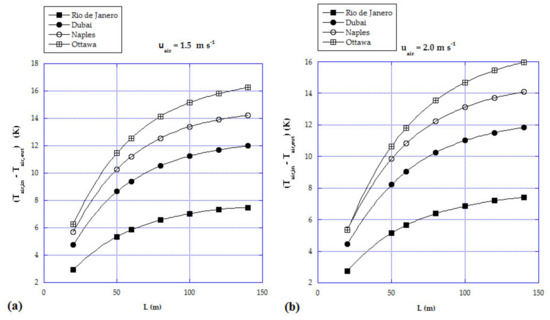
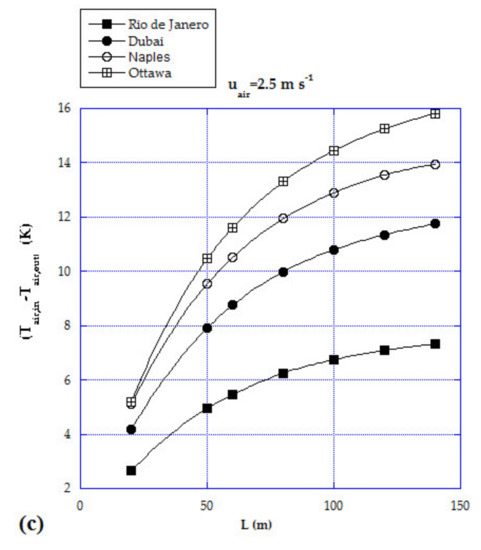
Figure 1. Temperature difference between the inlet and outlet temperature of the air flowing in the GAHX, as a function of tube length in summer season for: (a) 1.5 m s−1; (b) 2.0 m s−1; (c) 2.5 m s−1 velocity values.
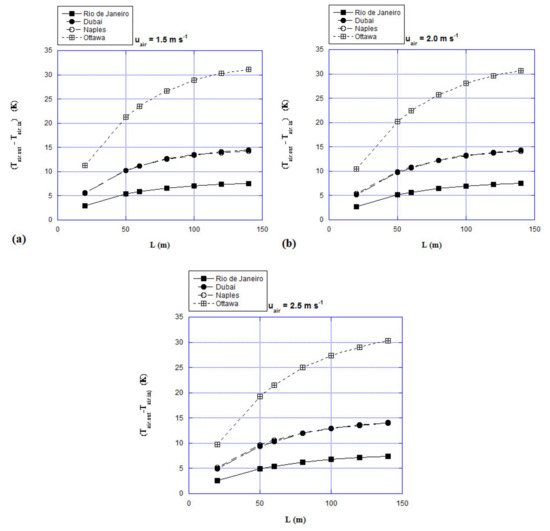
Figure 2. Temperature difference between the outlet and inlet temperature of the air flowing in the GAHX, as a function of tube length in winter season for: (a) 1.5 m s−1; (b) 2.0 m s−1; (c) 2.5 m s−1 velocity values.
From Figure 1, with reference to summer season, one can notice that:
-
the greatest values of temperature variation are those pertaining to Ottawa, with maximum values up to 16 K;
-
the lowest values are those pertaining to Rio (with maximum values lower than 8 K).
From Figure 2, with reference to winter season, one can notice that:
-
the greatest values of temperature variations are those pertaining to Ottawa (with maximum values greater than 30 K);
-
the temperature variations that can be obtained in GAHX in Naples are similar to those that can be obtained in Dubai);
-
the lowest values are obtained in Rio de Janeiro (with maximum values lower than 8 K).
Since the plotted air temperature spans between GAHX inlet and outlet are, on equal length, quite comparable for the three different velocity values, we can suppose to work with 2.5 m s−1 as air flow velocity in order to build the system with a minimized number of parallel pipes. As a matter of fact, as specified in Table 1, with the specific of keeping constant at 1300 m3 h−1 the volumetric flow rate of the air supplied to the building, the number of parallel tubes must vary with the air flow velocity, and for 2.5 m s−1 five parallel tubes are required. This solution ensures lower installation costs both in terms of materials and labor; moreover, a smaller number of pipes makes it possible to install the GAHX even for cases with a smaller surface area.
To exhaustively represent the temperature changes in the GAHX for the cities under investigation, belonging to very different climatic zones, in Figure 3 is reported the air temperature at the outlet of the GAHX tubes flowing with 2.5 m s−1, as a function of tube length in summer and winter for the four cities: (a) Rio de Janeiro; (b) Dubai; (c) Naples; (d) Ottawa. From the figure remarkable are the amplitudes of the temperature excursions between summer and winter for external air (visible at L = 0 m), as well as the progressive convergence to the ground temperature, with respect to the pipe length, of the air flowing into the GAHX. To the cities with greater temperature excursions are associated larger temperature spans (as confirmed by Figure 1 and Figure 2).
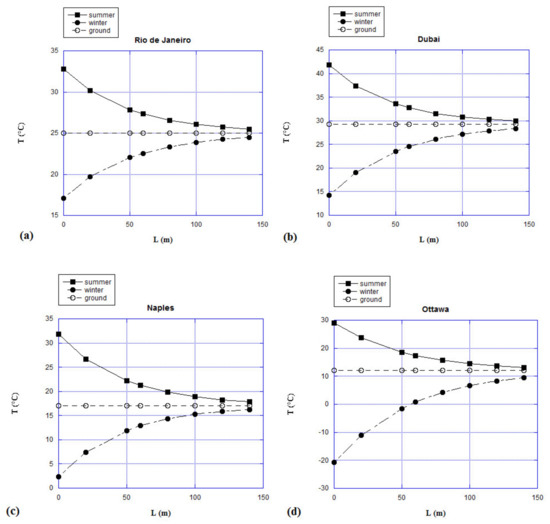
Figure 3. Temperature of the air flowing with 2.5 m s−1 velocity into the GAHX as a function of tube length in winter and summer season for: (a) Rio de Janeiro; (b) Dubai; (c) Naples (d) Ottawa.
The undisturbed soil temperature is about constant and close to the annual mean values of the external air. Therefore, the soil temperature in D or C zone is lower than that of A or B. The heat exchange between the soil and the air passing through the buried pipe is governed by the temperature difference between soil and air up to a great extent. Thermal performance of simple GAHX system significantly depends on the ground temperature of the place in which it is installed. The high value of the thermal diffusivity of the soil in Rio de Janeiro scarcely affects the heat transfer process. Indeed, a lower thermal diffusivity influences the air outlet temperature because of the heat accumulation and thermal saturation of the soil only, that happens during continuous running operation. Figure 3 also clearly shows that, for each climatic zone, the heat exchange is very pronounced up to 100 m: for longer lengths, air temperature gradually approaches an asymptotic value. Therefore, a 100 m pipe length is a good compromise to enhance the GAHX thermal performances and minimize the costs. This data found correspondence with the investigations reviewed by Bordoloi et al. [2].
In Figure 4a,b is reported the efficiency in summer and winter season respectively, of the GAHX as a function of the tube length for the four cities when the air flow velocity is 2.5 m s−1. Form the figures, the relevant emerging data is the strong comparability of the efficiency values of the four cities, on equal length. Indeed, 100 m as length of each pipe also ensures the achievement of satisfactory efficiency values that settle around 86% for all four cities. This is an important result also when considering the comparison between an air-to-air heat exchanger and an ground-to-air heat exchanger. In fact, the efficiency of the first technology settles around a value of 70% or less [3][4][5][6].
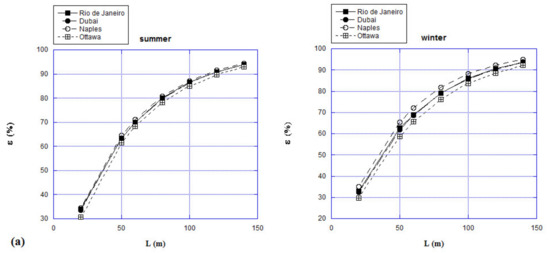
Figure 4. Efficiency of the GAHX, as a function of tube length for 2.5 m s−1 as air flow velocity in: (a) summer and (b) winter season.
In Figure 5, Figure 6 and Figure 7 the total thermal power reduction of the coils in the AHU during summer, winter and accounting both the seasons are, respectively, reported for the four cities by varying the length of the buried pipes of the GAHX and fixing the air flow velocity to 2.5 m s−1.
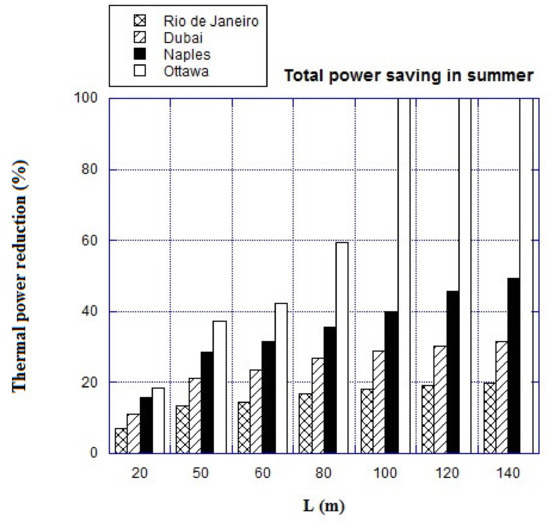
Figure 5. Percentage reduction of thermal power of the coils in the AHU during summer operation mode for the four cities by varying the length of the buried pipes of the GAHX and fixing the air flow velocity to 2.5 m s−1.
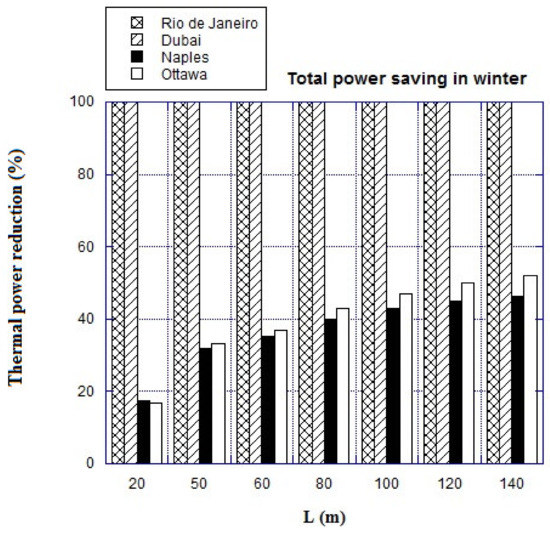
Figure 6. Percentage reduction of thermal power of the coils in the AHU during winter operation mode for the four cities by varying the length of the buried pipes of the GAHX and fixing the air flow velocity to 2.5 m s−1.
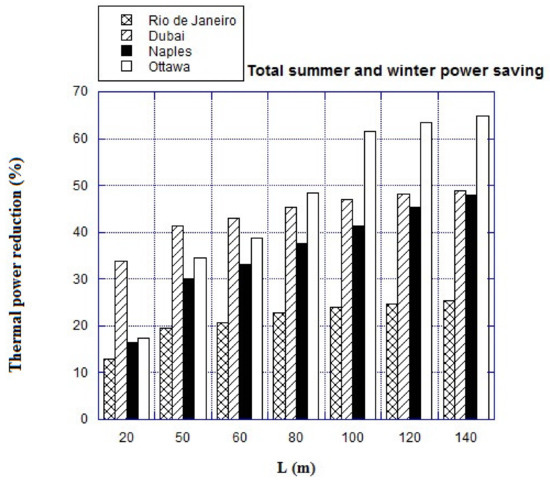
Figure 7. Total power percentage reduction for the coils in the AHU (during winter and summer operation modes) for the four cities by varying the length of the buried pipes of the GAHX and fixing the air flow velocity to 2.5 m s−1.
From Figure 5 one can notice that the highest power reductions were registered in Ottawa with a 100% value in summer for GAHX whose pipes length is 100 m. Worth of note about the data plotted in Figure 5 (referred to summer conditions) are the following aspects:
-
in the city of Naples, for lengths from 100 m, the temperature of the air exiting the pipes is lower than the dew point temperature, equal to 19.4 °C; therefore, the air is dehumidified and the outlet specific humidity ω decreases up to [13.75, 13.19; 12.86] g kg−1 respectively for [100; 120; 140] m pipe lengths. Clearly, to guarantee the thermo–hygrometric comfort the air flow exiting the GAHX undergoes a further process of cooling and dehumidification, by means of the cooling coil component of the AHU, up to 8.95 g kg−1. The corresponding mass flow rate of the condensed water mco
-
at the outlet of GAHX is [0.15; 0.40; 0.55] g s−1, respectively for [100; 120; 140] m pipe lengths;
-
in the city of Ottawa, for lengths from 60 m, the temperature of the air exiting the pipes is lower than the dew point temperature, equal to 17.6 °C; therefore, the air is dehumidified and the outlet specific humidity ω decreases up to [12.49, 11.19; 10.37; 9.85; 9.49] g kg−1 respectively for [60; 80; 100; 120; 140] m pipe length. The corresponding mass flow rate of the condensed water mc
-
at the outlet of GAHX is [0.06; 0.63; 0.99; 1.23; 1.38] g s−1 respectively for [60; 80; 100; 120; 140] m pipe lengths. In this city for a tube length greater than 100 m the GAHX is able to produce air at comfortable temperature and specific humidity and therefore there is no need of further cooling and dehumidification in the AHU. Therefore, the simple GAHX system works in stand–alone mode during summer, with a power reduction in summer season of 100% if the length of the tubes is equal or greater than 100 m.
Figure 6 reveals a number of remarkable aspects about the total power percentage reduction calculated for the winter season:
-
in the city of Rio de Janeiro, as reported in Figure 3a the temperature of the air flow exiting the GAHX from 20 m is greater than 20 °C, the minimum value required to guarantee the indoor thermo–hygrometric comfort. Moreover, the coupled values of specific humidity at the GAHX outlet is 9.18 g kg−1, that is very close to the desired comfort point. Indeed, the employment of GAHX system allows to not operate with the air conditioning system in winter mode, since the air exiting the GAHX could be directly entered in the building, only after a filtering operation to prevent the spread of viruses. Consequently, the total power reduction in AHU operating in heating mode is 100%;
-
also in the city of Dubai, as reported in Figure 3b the temperature of the air flow exiting the GAHX from 20 m is greater than 20 °C, the minimum value required to guarantee the indoor thermo–hygrometric comfort. Additionally, the coupled values of specific humidity at the GAHX outlet is 4.37 g kg−1, that could be considered close to an acceptable comfort point. Indeed, the employment of GAHX system allows to not operate with the pre– and post– heating coils of the air conditioning system in winter mode. Indeed, as it happens for the case of Rio de Janeiro, the air exiting the GAHX could be directly entered in the building (always after a filtering operation to prevent the spread of viruses), where it could be anyhow locally adiabatically humidified, not affecting the power reduction resulting from not using the heating coils. Consequently, also in Dubai the total power reduction in AHU operating in heating mode is 100%.
-
in the city of Naples the total power reduction in winter goes from 17.5% up to 46% respectively for 20 m and 140 m. The power reduction registered in Ottawa touches a maximum of 52% at 140 m. The power reduction values registered for these two cities are satisfying and usually higher than what would be obtained with an air–to–air heat exchanger (around 11%, according to [4]).
From Figure 7, that reports the overall power reduction calculated considering both the summer and winter operation mode, one can conclude that the employment of an ground-to-air system is convenient for all the cities. Specifically, the remarkable emerging data is that for smaller pipe lengths (lower than 80 m) the maximum total energy reduction are registered in Dubai, whereas longer tubes are required in Ottawa to become the city, among the four investigated, where the total power reductions are the greatest. For a tube length greater than 100 m, Napoli and Dubai show similar results. The lower values of power reduction are those pertaining to Rio de Janeiro.
It is important to underline how these thermal power reductions are directly related to economic savings. Particularly for some of the analyzed cities, when using the GAHX in heating or cooling mode the cost of the system would be decidedly reduced compared to a HVAC system with an usual AHU without the ground tube. However, further research activity will assess the actual technical-economic convenience, through the Discounted Payback Period index.
3. Conclusions
This paper reports the energy performances carried out by an investigation conducted on a HVAC system, composed by an air handling unit for the primary air coupled with a horizontal-pipes GAHX and fan-coil units, for an office building, supposed to be placed in four cities (Rio de Janeiro, Dubai, Naples, Ottawa) belonging to four different worldwide climatic areas according to the Köppen climate classification. The investigation is performed by means of a two-dimensional numerical model of an ground-to-air heat exchanger constituted by a variable number of circular horizontal buried pipes (for air flowing) installed at 2.5 m deep. The model has been experimentally validated with literature data [7] and a good agreement between numerical and experimental results was verified.
The results introduced in this paper are carried out by the simulations on the GAHX, performed by varying the length of the pipes and the air velocities; thus, also the number of tubes forming the GAHX is varied since the volumetric airflow rate to be provided to the AHU must be kept constant.
Once the outlet temperatures of the air at the exit of the buried tubes have been assessed, the GAHX is thermodynamically connected with the AHU, i.e. the external air pre-heated or pre-cooled by the geothermal heat exchanger is not directly introduced into the building but it is sent to the AHU. Subsequently the energy performances of the above-mentioned HVAC system are analyzed, both in summer and in winter operation modes. From the investigation the following conclusions could be drawn:
-
the air flow velocity is a parameter that does not confer significant variability of the GAHX temperature span trends, if the comparison is done, for each city, at fixed length and season;
-
for each climatic zone, the heat exchange is very pronounced up to 100 m: for longer lengths, air temperature gradually approaches an asymptotic value. Therefore, a 100 m pipe length is a good compromise to enhance the GAHX thermal performances and minimize the costs;
-
there is a strong comparability of the GAHX efficiency values for the four cities, on equal length, both in winter and in summer operation modes. Indeed, 100 m as length of each pipe also ensures the achievement of satisfactory efficiency values that settle around 86% for all four cities;
-
the introduction of the GAHX allows to not utilize the pre and re heating coils during winter in Rio de Janeiro and Dubai (with a reduction of 100% on the heating power);
-
the introduction of GAHX allows to not utilize cooling coils during summer in Ottawa, if the tube length is equal or greater than 100 m, (with a reduction of 100% on cooling power of the HVAC system);
-
the best value of thermal power reduction (61.5%) for a 100 m pipe-length ground-to-air heat exchanger is obtained in Ottawa, a city belonging to continental climate zone (D Zone);
-
the worst results in terms of thermal power reduction are registered in Rio de Janeiro, a city belonging to the tropical or equatorial climates (A Zone), that for a 100 m pipe-length ground-to-air heat exchanger is 23.9%.
These results lead to say that this system (GAHX for the geothermal pre-treatment of the air to be introduced into the AHU), is energetically very convenient; it is competitive if compared to the usual solution based on the air-to-air heat exchanger (which is also less suitable for the spread of coronavirus and similar viruses). Furthermore, authors are aware that the results presented in this paper constitute only one of the points of investigations of a much wider global analysis. Indeed, future works will deepen: (i) the analysis of the performance of the system in dynamic conditions, using daily climatic data; (ii) the investigation on the economic convenience of the GAHX employment for the different analyzed climatic conditions; (iii) an analysis of the system optimization considering both thermal-energetic performances and an economic analysis.
References
- Deliang Chen; Hans Weiteng Chen; Using the Köppen classification to quantify climate variation and change: An example for 1901–2010. Environmental Development 2013, 6, 69-79, 10.1016/j.envdev.2013.03.007.
- Bordoloi, N.; Sharma, A.; Nautiyal, H.; Goel, V; An intense review on the latest advancements of Earth Air Heat Exchangers. Renew. Sustain. Energy Rev. 2018, 89, 261–280.
- Cheng Zeng; Shuli Liu; Ashish Shukla; A review on the air-to-air heat and mass exchanger technologies for building applications. Renewable and Sustainable Energy Reviews 2017, 75, 753-774, 10.1016/j.rser.2016.11.052.
- Rasool Kalbasi; Behrooz Ruhani; Sara Rostami; Energetic analysis of an air handling unit combined with enthalpy air-to-air heat exchanger. Journal of Thermal Analysis and Calorimetry 2020, 139, 2881-2890, 10.1007/s10973-019-09158-9.
- Shunian Qiu; Shan Li; Fei Wang; Yang Wen; Zhenhai Li; Zhengwei Li; Jianfeng Guo; An energy exchange efficiency prediction approach based on multivariate polynomial regression for membrane-based air-to-air energy recovery ventilator core. Building and Environment 2019, 149, 490-500, 10.1016/j.buildenv.2018.12.052.
- Gabriel Rojas; R. Pfluger; W. Feist; Cascade ventilation—Air exchange efficiency in living rooms without separate supply air. Energy and Buildings 2015, 100, 27-33, 10.1016/j.enbuild.2015.02.014.
- Mohamed Khabbaz; Brahim Benhamou; Karim Limam; Pierre Hollmuller; Hassan Hamdi; Amin Bennouna; Experimental and numerical study of an earth-to-air heat exchanger for air cooling in a residential building in hot semi-arid climate. Energy and Buildings 2016, 125, 109-121, 10.1016/j.enbuild.2016.04.071.




